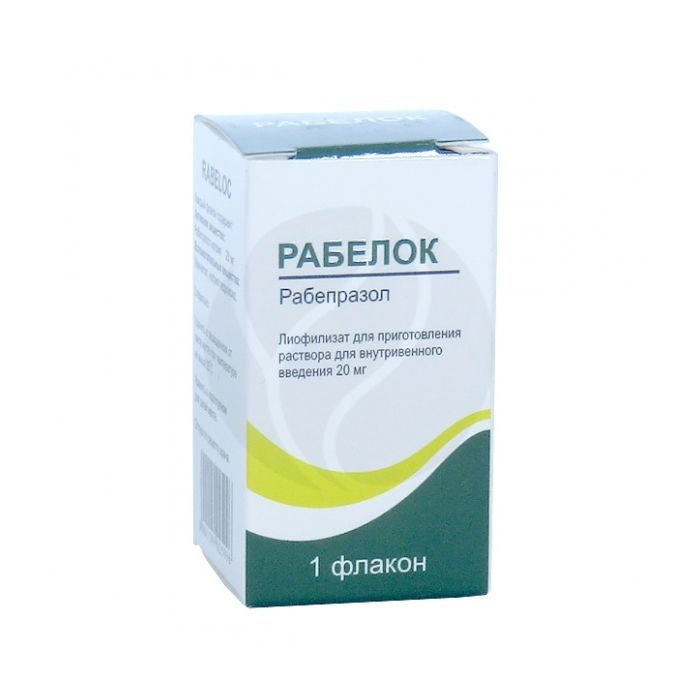Rabelok lyophilisate 20mg, No. 1
Expiration Date: 11/2025
Russian Pharmacy name:
Рабелок лиофилизат 20мг, №1
Peptic ulcer and duodenal ulcer in the acute phase;
peptic ulcer and duodenal ulcer associated with Helicobacter pylori (in combination with antibiotics);
gastroesophageal reflux.
The reception mode is individual.
Lyophilisate for the preparation of a solution for intravenous administration in the form of a lyophilized mass or powder from almost white to light yellow.
1 fl.
rabeprazole sodium 20 mg
Excipients: mannitol 75 mg, sodium hydroxide to pH 11.0.
Pregnancy,
lactation period (breastfeeding),
hypersensitivity to sodium rabeprazole or substituted benzimidazoles.
pharmachologic effect
Antiulcer agent, inhibitor of H + -K + -ATPase (proton pump). The mechanism of action is associated with the inhibition of the enzyme H + -K + -ATPase in parietal cells of the stomach, which leads to blocking the final stage of the formation of hydrochloric acid. This action is dose-dependent and leads to inhibition of both basal and stimulated secretion of hydrochloric acid, regardless of the nature of the stimulus.
Side effect
From the digestive system: diarrhea, nausea, abdominal pain, vomiting, flatulence, constipation; rarely - dry mouth, indigestion, belching; in isolated cases - anorexia, gastritis, stomatitis, increased activity of hepatic transaminases.
From the side of the central nervous system and peripheral nervous system: headache, asthenia, dizziness, insomnia; rarely - nervousness, drowsiness; in isolated cases - depression, impaired vision and taste.
From the respiratory system: possible - rhinitis, pharyngitis, cough; rarely - sinusitis, bronchitis.
Allergic reactions: rarely - skin rash; in isolated cases - itching.
Others: back pain, flu-like syndrome; rarely - myalgia, chest pain, chills, calf muscle cramps, urinary tract infection, arthralgia, fever; in isolated cases - an increase in body weight, increased sweating, leukocytosis.
Application during pregnancy and lactation
Rabeprazole is contraindicated during pregnancy and lactation.
In experimental studies, it was found that rabeprazole in small quantities penetrates the placental barrier, but there were no violations of fertility or fetal developmental defects; excreted in the milk of lactating rats.
There is no clinical experience with rabeprazole in children, so the use is not recommended.
Application for violations of liver function
Patients with impaired liver function do not require dose adjustment, but in patients with severely impaired liver function, rabeprazole is recommended to be used with caution.
Application for impaired renal function
No dose adjustment is required in patients with impaired renal function.
special instructions
Before starting therapy, it is necessary to exclude malignant neoplasms of the stomach, because the use of rabeprazole can mask symptoms and delay correct diagnosis.
Patients with impaired liver or kidney function do not require dose adjustment, however, in patients with severely impaired liver function, rabeprazole is recommended to be used with caution.
When used simultaneously with rabeprazole, the doses of ketoconazole and digoxin should be adjusted.
In experimental studies, the carcinogenic effect of rabeprazole has not been established, however, when studying mutagenicity, ambiguous results were obtained. Tests on lymphoma cells in mice were positive, with an in vivo micronucleus test and an in vivo and in vitro DNA repair test negative.
Drug interactions
With simultaneous use with digoxin, an increase (from small to moderate) in the concentration of digoxin in the blood plasma is possible.
When used simultaneously with ketoconazole, its bioavailability decreases.

